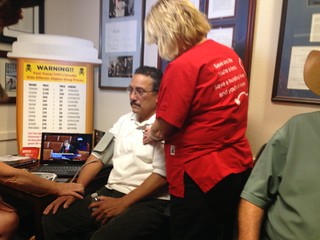Fighting to Stop Fast Track/TPP, RNs call on all Nurses, Supporters to Rise Up
Staff members expecting a quiet morning at Rep. Jim Costa’s Fresno office—underestimated what can happen when Congress members vote to endanger public health, with a trade deal that could balloon medication costs, overturn nurse-to-patient ratios, and destroy the environment.
Cue the nurses.
 “I came out today because it’s important to get Costa to reverse his ‘yes’ vote on aspects of a trade agreement which would cause the public to pay more for medications and let corporations overturn laws, like nurse-to-patient ratios, if they were seen as barriers to profit,” says Susan Burr, RN, of Kaiser Fresno. Burr, along with other National Nurses United members and community organizations, joined a sit-in at Rep. Costa’s office Tuesday morning to hold Costa accountable.
“I came out today because it’s important to get Costa to reverse his ‘yes’ vote on aspects of a trade agreement which would cause the public to pay more for medications and let corporations overturn laws, like nurse-to-patient ratios, if they were seen as barriers to profit,” says Susan Burr, RN, of Kaiser Fresno. Burr, along with other National Nurses United members and community organizations, joined a sit-in at Rep. Costa’s office Tuesday morning to hold Costa accountable.
Last week, Rep. Costa voted yes on two sections of a three-part bill that would allow “Fast Track” approval for the risky Trans-Pacific Partnership (TPP). One section was struck down, stalling the entire “Fast Track” bill. A re-vote, initially slated for today, was just put off as late as July 30—largely because unions and community groups ensured Fast Track supporters weren’t able to turn enough votes that quickly. RNs say between now and July, they will continue fighting for all reps to vote on the right side of public health.
Nurses will be launching a billboard campaign, in addition to continuing to visit and call representatives across the country to ensure they don’t harm our patients, working families or communities.
“Rep. Costa’s recent vote would pave the way for extending the amount of time pharmaceutical companies have before a drug could go generic. As a healthcare provider, I know firsthand that would lead to people with diseases that could’ve been prevented or controlled—like diabetes or hypertension,” says Burr. “If they couldn’t afford medication, you’d be seeing more patients coming in to the hospital, sick.”
 At today’s sit-in, RNs and community groups turned up the heat on Rep. Costa to reverse his position. According to nurses, his staff responded in kind, literally—by shutting off the air conditioning. While trying to sweat out the nurses and community groups, Costa’s staff also refused the bathroom key and eventually called an officer from the Department of Homeland Security (who allowed the sit in to continue). The RNs stayed throughout the morning, speaking to media and also monitoring members of local community groups who were on a hunger strike.
At today’s sit-in, RNs and community groups turned up the heat on Rep. Costa to reverse his position. According to nurses, his staff responded in kind, literally—by shutting off the air conditioning. While trying to sweat out the nurses and community groups, Costa’s staff also refused the bathroom key and eventually called an officer from the Department of Homeland Security (who allowed the sit in to continue). The RNs stayed throughout the morning, speaking to media and also monitoring members of local community groups who were on a hunger strike.
“I want people to know that nurses care about our patients—and our future patients. We care about the public and their healthcare,” says Burr, adding that she expects elected leaders to do the same. “I’d like for Rep. Costa to listen to what the people want—not what’s good for big business but what is good for the people.”
When elected leaders don’t listen to public health concerns, as NNU members are proving in Fresno and across the country, they will have to answer to the most trusted profession in America: The nurses.
THIS STORY ISN’T OVER. WE NEED YOUR HELP!
The Fresno RNs held their ground today, but the Trans-Pacific Partnership will impact all patients—and the entire public at-large.
The voice of nurses is absolutely critical—from this moment, through to the end of July vote. We MUST hold our ground to ensure corporations cannot Fast Track the TPP, thereby inflating medication costs and steamrolling laws we fought so hard to enact, like nurse-to-patient ratios in California.